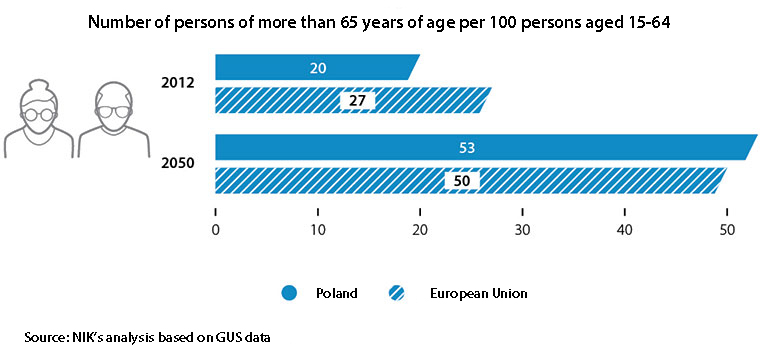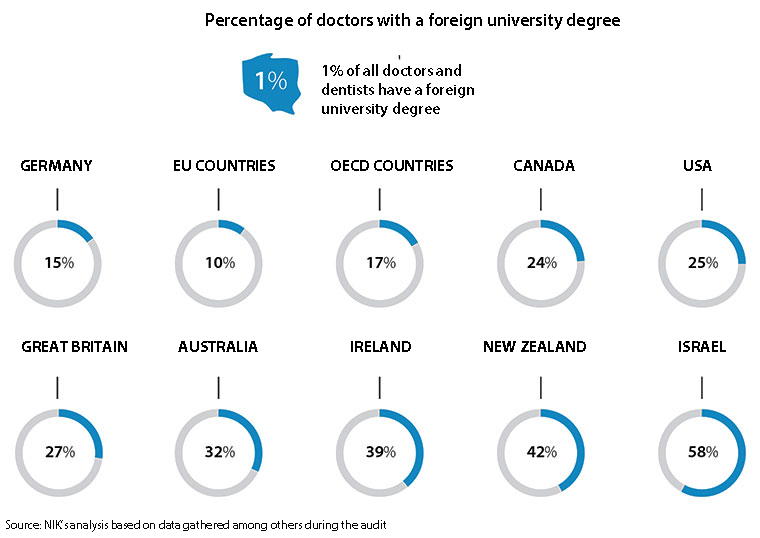In the audited period (from January 2017 to mid-2020), the biggest barrier for foreigners was the diploma validation process. The key issue, apart from differences in education systems in individual countries, was regulations adopted by Polish universities, often in breach of the applicable law.
Also attempts to draft an act that would allow applying the same provisions of law to non-EU foreigners as to EU citizens have proved unsuccessful.
The phenomenon of migration could not be fully monitored or analysed because there was no functional database in place. Information was gathered in many non-integrated public registers which did not comprise all foreigners working in Poland. Moreover, none of those systems included information on immigrants’ qualifications, vital for the economy: their education, acquired profession and professional experience. According to the audited institutions, that was not allowed under the personal data protection law. In line with the government’s declaration, a functional, integrated register is to be created by 2030.
The Ministry of Health provided the most detailed analyses and studies of the labour market needs. That was the only ministry which helped adopt legal solutions partly facilitating validation of diplomas to non-EU foreigners – doctors and dentists. However, the Ministry of Health did not take steps to encourage foreigners to settle in our country and find a medical job. The issue of the so-called bridging studies for nurses and midwives (bachelor studies addressed to persons with secondary education who wanted to raise their qualifications) remained unsolved. Despite the Ministry’s positive opinion, district chambers of nurses and midwives refused to grant professional licences to foreigners based on certificates of graduation from Polish universities. Some foreigners contesting that decision filed their cases to courts.
Needs of the labour market and efforts taken by the audited institutions
Pursuant to forecasts made by the EU Statistical Office (Eurostat) and the Polish Central Statistical Office (GUS), the Polish population will decline by about 4 million until 2050. The forecasts are also similar as regards the key issue which is the systematic aging of our society. In 2012, in Poland there were 20 persons of more than 65 years of age per 100 persons aged 15-64 (so-called demographic dependency ratio). In 2050, it should be 53 persons.

Experts have alerted for a long time now that unfavourable demographic trends, such as birth rate below the so-called generation replacement rate, falling percentage of persons at working age and a spike in the percentage of elderly persons in the whole population, have become the biggest challenge for our labour market and thus for the pension fund and healthcare.
The World Bank economists indicate Poland as an example that migration may positively impact economic development due to an increase in consumption of goods and services and more frequent investments in Poland. Analyses made by the audited ministries revealed that immigration in Poland in the audited period was mostly driven by economic factors and that foreigners treated it as a temporary situation. It means that persons who arrived in Poland were mostly blue-collar workers with low qualifications or persons who found jobs below their qualifications. Usually they wanted to work in Poland for some time only.
The key problems, risks and challenges related to hiring foreigners were addressed in the course of works of inter-ministerial teams designated to prepare strategic documents on migration. Experts also recommended taking specific actions. No solutions were developed, though, to underpin the system of validating diplomas of non-EU foreigners or to support foreigners in their attempts to have their degrees recognised.
All of the audited ministries monitored the needs of the labour market. Their analyses clearly showed that it is more and more difficult to find qualified employees, especially in medical professions. The Minister’s ordinance did not define which of those professions were desired and no jobs were offered to foreigners who gained their qualifications in non-EU countries. The focus was only on law-making and information activities addressed to all foreigners. Those measures made it easier for job searchers to find legal employment.
The audited provincial offices lacked reliable information about the actual number of employed foreigners and their qualifications. The reason was limited functionality of registers and databases. The lack of comprehensive knowledge about foreigners’ working capacity made it impossible to fully identify, monitor and predict their situation, and thus recommend solutions that would be of benefit both to foreigners and to the whole region.
The situation did not help define criteria for the issue of work permits to foreigners and for optimal implementation of projects financed from the Asylum, Migration and Integration Fund. The Fund offered, among other things, legal, vocational, language and adaptation assistance to foreigners. At the same time, foreigners had access to information on requirements to obtain specific types of temporary residence permits or work permits. Not all issues were settled on a timely basis, though. Reasons included staff shortages and a growing number of customers’ claims or complaints filed with public institutions (a few tens of percent increase per year).
Analyses of local labour markets clearly indicated that the professional potential of foreigners working in provincial offices is not fully used as they often took up jobs below their professional qualifications.
Medics - most wanted?
The analyses and studies of the labour market needs developed by the Ministry of Health were most detailed of all ministries. However, they were limited to selected medical professions – doctors, dentists, nurses, midwives, physiotherapists, pharmacists and laboratory diagnosticians. In the course of the audit works were pending on the final draft of the act, assuming the settlement of qualification requirements for 15 of 22 remaining medical professions.
The data gathered by the Ministry helped among others create the maps of health needs, including available medical staff. They reveal that at the end of 2019, the number of doctors and dentists in Poland went up by nearly 5% as compared with 2016. As for professionally active nurses and midwives it was about 4% increase in that period.
Among others on that basis forecasts were made which allowed precise calculations showing why the generation replacement rate could not be achieved in medical professions. That indicated what would be the deficit of nurses and midwives, considering the current rate of obtaining professional licences, and also how many persons additionally should be granted that licence to ensure this replacement rate.
The forecasts did not include acquisition of foreigners who underwent medical education abroad, although that alternative path, due to the time-consuming education process, was mentioned in the report “A study of stability of supply and demand of work performed by healthcare workers in Poland”. The document prepared by the Ministry of Health in cooperation with experts, recommended hiring doctors, especially across the Eastern border of Poland. As for nurses and midwives, that solution was not proposed in any document.
In 2019, only 1 823 foreigners being doctors or dentists had the medical licence, which made up about 1% of doctors and dentists in total. In Germany it was 15%, in Great Britain 27% and in Israel as much as 58% at that time.

In line with the data provided by the Ministry of Health, at the end of 2019, among foreigners with professional licence there were also 243 nurses (0.10% of all professionally active nurses) and 15 midwives (0.05% of all professionally active midwives).
Validation of foreign diplomas
The first and foremost barrier in the process of recognising foreigners’ professional qualifications (impossible to cross, for some of them), was validation of a degree obtained in a non-EU country. Reasons included regulations adopted in some universities, often in breach of applicable laws.
In the audited period, in five universities covered by the audit, as many as 1778 requests to validate a foreign diploma were filed, most of them in the Medical University in Białystok - 856 (nearly 46% diplomas were validated), and least in the Medical University of Silesia – 16 (of which none was validated).
There were significant differences between the number of candidates applying for their diploma validation and the pass rate of the diploma validation exams in the audited universities. That was a clear signal, also for foreigners, that in some cases it was the inconsistency of the proceedings which determined their outcome.
The Medical University in Białystok was the only school where the rector’s regulations and resolutions passed by the councils of individual departments defined general principles to apply in such proceedings, in the whole audited period. That was the university where most diploma validation requests were placed and, more importantly, most of the proceedings were successful. In three audited universities, standardised regulations were implemented only in 2019-2020. In one school – the Medical University in Łódź – they were not introduced until the end of the NIK audit.
All of the audited universities analysed documentation submitted by foreigners to compare their academic syllabi, education results and occupational licences, work practice and duration of studies. In case they found some differences, applicants had to pass an exam, where the pass rate threshold was set at 55- 70% of correct answers.
In 2020, the Minister of Health initiated and led to the adoption of legal solutions partially facilitating validation of professional qualifications of non-EU doctors and dentists. Since 1 January 2021, the diploma validation has no longer been required, now it is enough to pass a verification exam. Foreigners can also undergo a post-graduate internship in line with the principles applicable to Polish citizens. Also, the Minister of Health’s consent to specialisation training in Poland is not required anymore.
The Ministry of Health did not take efforts to encourage foreigners to settle in Poland and get hired in medical professions. It also lacked data on the number of foreigners who did not take up jobs in line with their medical qualifications. Due to the lack of data it could not be stated if the low employment level among non-EU foreigners in medical professions is related to barriers in access to this type of jobs in Poland or little attractiveness of the Polish labour market for those persons.
Professional licence
Following validation of diplomas, the next stage on the way to employment in Poland is to obtain professional licence from medical chambers or chambers of nurses and midwives. In 2017-2020 (first half), in the audited district medical chambers the total of 589 professional licensure proceedings were conducted. Most frequently the applicants came from Ukraine, Belarus and Russia. All in all, the chambers granted licences to 562 doctors and one dentist.
In case of nurses and midwives educated outside the EU, an obstacle in obtaining a professional licence was related to unclear procedures. Also requirements as to documents that need to be delivered varied by the region.
In 2017-2020 (first half), in the audited chambers of nurses and midwives, 120 non-EU foreigners (mainly from Ukraine but also from Belarus, Russia, Kazakhstan, Cameroon, Egypt, India, Armenia and Ghana) were covered with professional licensure proceedings. The chambers granted professional licences to 71 persons.
The issue of the so-called bridging studies remained unsolved in the audited period. According to the Minister of Health, nurses (e.g. from Ukraine) having certificates of graduation from nurse schools in their own countries may undergo bridging studies in Poland, provided that after graduation they start employment in Poland. However, in the opinion of the Supreme Chamber of Nurses and Midwives, also in line with the Directive of the European Parliament and of the Council, the licence may be granted only to persons who graduated from full-time bachelor studies, taking at least 6 semesters, covering both theory and practice. According to the Chamber, the bridging studies (extramural, up to 5 semesters) were a solution only for Polish nurses educated in the previous system, i.e. in medical secondary and vocational schools. As a consequence of those discrepancies, some foreigners with certificates of graduation from bridging schools filed their cases to courts. In Poznań, there were 25 proceedings of that type pending in the audited period.
Recommendations
NIK has addressed several recommendations to the President of the Council of Ministers which require cross-ministerial actions:
- to coordinate and support works of the Minister of Internal Affairs and Administration in preparing the Migration Policy of Poland;
- to extend the system of recognising professional qualifications in regulated professions - now applicable only to EU citizens - to the citizens of non-EU countries;
- to intensify and accelerate works on registers and databases on foreigners, to enable multi-aspect analyses, monitoring and forecasts related to migration and effective planning of tasks to support foreigners;
- to build social awareness that it is necessary to open the Polish labour market for non-EU citizens.


